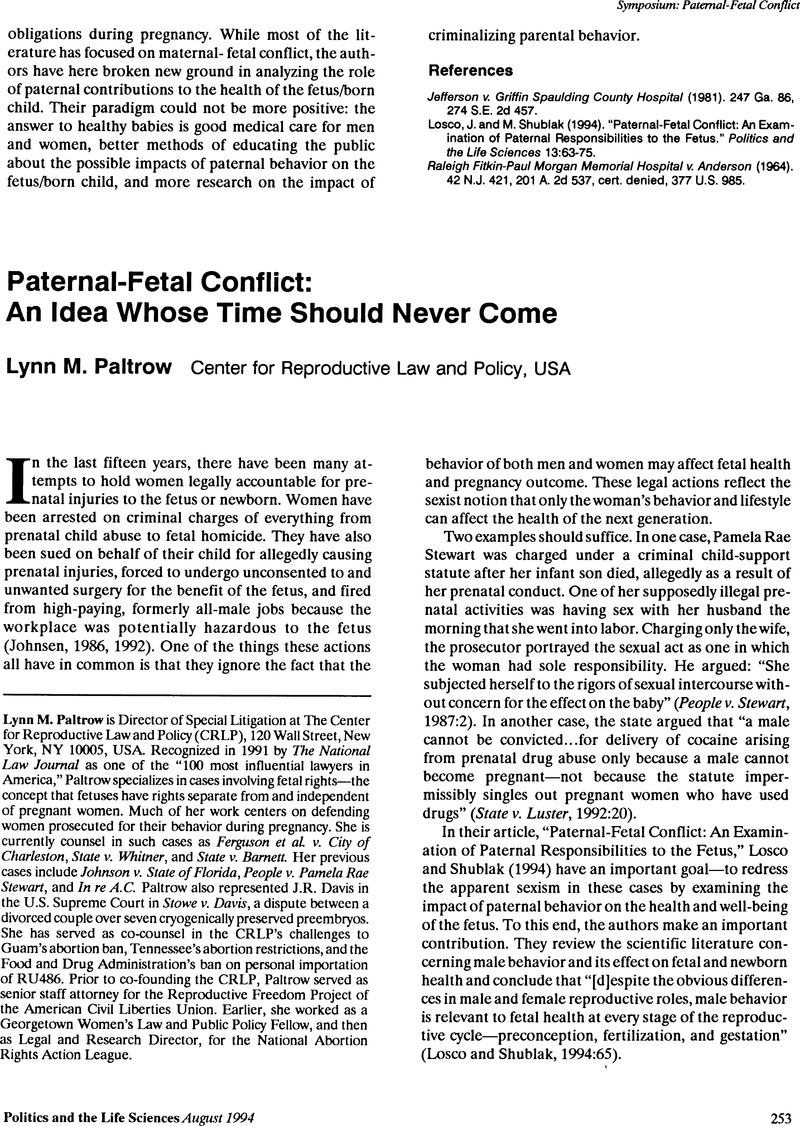No CrossRef data available.
Article contents
Paternal-Fetal Conflict: An Idea Whose Time Should Never Come
Published online by Cambridge University Press: 17 May 2016
Abstract
An abstract is not available for this content so a preview has been provided. Please use the Get access link above for information on how to access this content.

- Type
- Symposium: Paternal-Fetal Conflict
- Information
- Copyright
- Copyright © Association for Politics and the Life Sciences
References
American College of Obstetricians and Gynecologists Committee (1987). Patient Choice: Maternal-Fetal Conflict. Opinion No. 55.Google Scholar
American Medical Association Board of Trustees (1990). “Legal Interventions During Pregnancy.” Journal of the American Medical Association 264:2663.Google Scholar
Annas, G.J. (1990). “Foreclosing the Use of Force: A.C. Reversed.” Hastings Center Report 27 (July/August).Google Scholar
Center for Reproductive Law and Policy (1992). Punishing Women For Their Behavior During Pregnancy: A Public Health Disaster. New York: Fact sheet produced by Center for Reproductive Law and Policy.Google Scholar
Gallagher, J. (1987). “Prenatal Intrusions and Interventions: What's Wrong with Fetal Rights.” Harvard Women's Law Journal 10:9.Google Scholar
Johnsen, D.E. (1986). “The Creation of Fetal Rights: Conflicts with Women's Constitutional Rights to Liberty, Privacy, and Equal Protection.” Yale Law Journal 95:599.CrossRefGoogle Scholar
Johnsen, D.E. (1992). “Shared Interests: Promoting Healthy Births Without Sacrificing Women's Liberty.” Hastings Law Journal 43:569.Google Scholar
King, P.A. (1989). “Should Mom be Constrained in the Best Interest of the Fetus?” Nova Law Review 13:393–404.Google Scholar
King, P.A. (1991). “Helping Women Helping Children: Drug Policy and Future Generations.” The Milbank Quarterly 69:595.Google Scholar
Kolder, V. et al.(1987). “Court Ordered Obstetrical Interventions.” New England Journal of Medicine 316:1191.Google Scholar
Losco, J. and Shublak, M. (1994). “Paternal Fetal Conflict: An Examination of Paternal Responsibilities to the Fetus.” Politics and the Life Sciences 13:63–75.Google Scholar
Marshall, A.B. (1993). “Perinatal Addiction Research and Education Update.” 1993 Legislative Update. New York: Fact sheet produced by Center for Reproductive Law and Policy.Google Scholar
Nelson, L.J. et al.(1986). “Forced Medical Treatment of Pregnant Women: ‘Compelling Each to Live as Seems Good to the Rest.’” Hastings Law Journal 37:703.Google Scholar
People v. Stewart (1987). Points and Authorities in Opposition to Defendant's Demurrer and Motion to Dismiss. No. M508197.Google Scholar
Poland, M. et al.(1993). “Punishing Pregnant Drug Users: Enhancing the Flight from Care.” Drug and Alcohol Dependence 31:199.Google Scholar
Roberts, D.E. (1991). “Punishing Drug Addicts Who Have Babies: Women of Color, Equality, and the Right of Privacy.” Harvard Law Review 104:1419–83.Google Scholar
Thornton, T. et al.(1991). “The Rights of Pregnant Patients Brings Bold Policy Initiatives.” Healthspan 8:10.Google Scholar
United States General Accounting Office (1991). Women's Set-Aside Does Not Assure Drug Treatment for Pregnant Women. Report to the Chairman, Subcommittee on Health and Environment, Committee on Energy and Commerce, United States House of Representatives. GAO/HRD-91-80.Google Scholar


